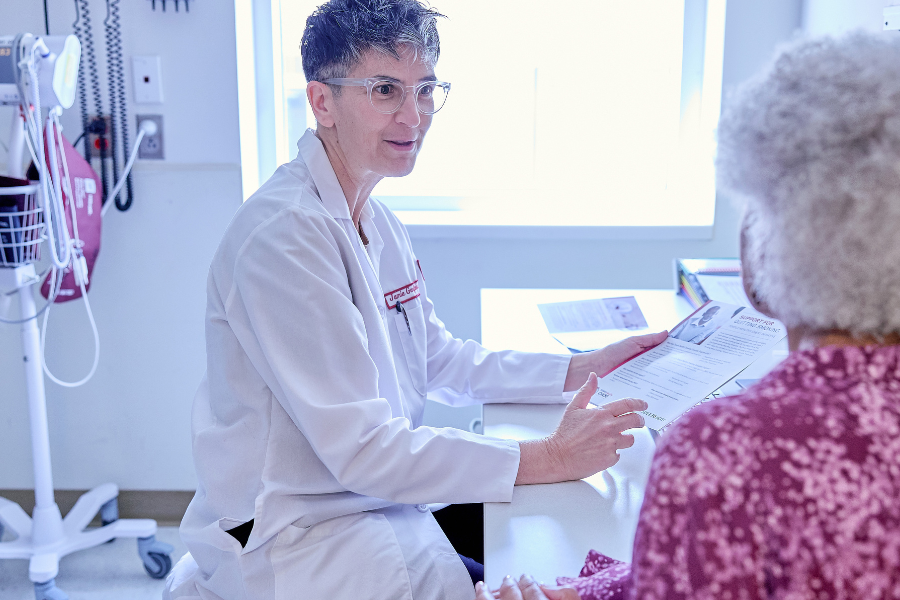Lung cancer is the most common cause of cancer-related deaths in the U.S., and around 85% of cases are thought to be related to smoking. As a lung cancer specialist, I tell my patients who smoke that quitting is the very best form of protection from the disease, but I also emphasize that for some people who have smoked, lung cancer screening is also beneficial.
Often, lung cancer doesn’t have early symptoms and is not caught until it has reached an advanced stage. Screening with low-dose CT (LDCT) scans, however, can help catch lung cancer sooner, when it’s most treatable. These advanced imaging tests can detect lung cancer in early stages when treatment can be successful. In fact, we have good evidence to show that yearly low-dose CT screening can reduce deaths in people at high risk for lung cancer.
That’s why I make a point to discuss LDCT scans with my patients. While screening for lung cancer isn’t for everyone, for the right candidates it can save lives.
For patients who are current or past smokers, and who I’ve suggested to get yearly lung cancer screenings, here are five facts I share with them.
1. Screening guidelines have recently changed.
Screening has long been recommended for certain adults who smoke or used to smoke but don’t currently have lung cancer symptoms. Recently updated screening guidelines mean that many more people are now eligible for yearly LDCT scans than before.
LDCT scans are now recommended for those who are:
- Between ages 50 to 80 and in fairly good health. This means you don’t have a serious medical condition that would shorten your life expectancy and you are healthy enough to potentially withstand treatment like surgery or if cancer is found. If you’re unsure whether your health qualifies, talk with your doctor.
- AND you currently smoke or have quit in the past 15 years.
- AND you have a smoking history of 20-pack years or more. A person who has smoked one pack a day for 20 years or two packs a day for 10 years has a 20-year pack history.
2. Screening can find lung cancer at an earlier stage.
One of the most important points I emphasize with patients is that the earlier lung cancer is found, the better chance a patient has of being treated successfully. Patients may also be in a better position to receive minimally invasive surgery and have less lung tissue removed.
LDCT scans are better than chest x-rays at detecting very small lung nodules, and they also have the capability to show a nodule’s size, shape, and positioning. If a nodule of concern is detected, we may watch it with a repeat CT scan. If it is concerning, we may recommend additional testing or even a biopsy to understand if it is cancer.
It’s important to note that while LDCT scans are highly effective at catching early lung cancers, not every cancer caught by screening is treatable. Depending on when a person begins getting scanned and other factors, it’s still possible for lung cancer to spread or become more advanced before being detected with a screening test.
3. Screening with an LDCT scan is quick, easy, and painless.
A LDCT scan involves lying on a CT exam table, raising your arms over your head, and holding your breath for a few 5- to 10-second scans. Unlike regular CT scans, there are no painful injections. In fact, there aren’t any side effects, and most people find it comfortable even if they typically have trouble holding their breath. If you have a metal part in your body, like a pacemaker or an artificial joint, it won’t be affected by the scan.
4. It’s low radiation.
LDCT scans expose you to a small amount of radiation. The dose is a bit higher than a chest x-ray but considerably lower than a standard CT scan. I tell my patients that if they’re a candidate for LDCT scans, the benefits of catching lung cancer early significantly outweigh the small radiation exposure risks.
5. Screening may spot other conditions.
The goal of LDCT screening is to detect early lung cancer, but it’s possible that a scan could spot something else in a patient’s lungs that isn’t cancer, which might need to be addressed.
Where you get screened matters
Ask your doctor if lung cancer screening is right for you. I emphasize that screening should be done at facilities with specialized CT scanners, by experts who have experience in screening, diagnosing, and treating lung cancer. Through the Temple Healthy Chest Initiative, we screen thousands of people each year for lung cancer using LDCT scans. And if cancer is detected, state-of-the-art treatment is available at Temple’s Fox Chase Cancer Center – Lung Cancer Program.
You can schedule a lung cancer screening at any of our convenient locations by calling 800-TEMPLE-MED or scheduling an appointment online.
Lung cancer screening is offered at Temple University Hospital, Temple University Hospital - Jeanes Campus, Temple Health Oaks, Temple Lung Center at Chestnut Hill, and the Fox Chase Cancer Center
Helpful Resources
Looking for more information?

